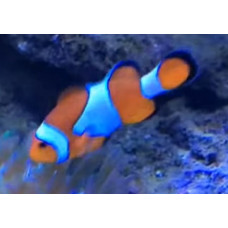Latin name
Amphiprion ocellaris
Other names
False percula clownfish, common clownfish.
Identification
The body is stocky and oval in shape. It is compressed at the sides and has a rounded profile.
Features of fish fins
The dorsal fin has 10-11 hard and 13-17 soft rays, the anal fin has two hard and 11-13 soft rays, and the pectoral fin has 16-18 rays.
Fish colouring
The body colour is red-orange with three vertical white stripes: on the head, on the middle part of the torso and on the base of the tail. The trunk stripe is triangular.
Distribution
Widespread off the coast of Indochina, the Andaman and Nicobar Islands, the Indo-Malay Archipelago, the Philippines, Taiwan and the southern Ryukyu Islands, and off the northern coast of Australia.
Habitat
Marine, tropical, reef dweller. Depth range from 1 to 15 m, usually 3 to 15 m. Found in shallow and calm lagoons.
Size
They are up to 11 centimetres long.
Behavior
They do not migrate. They live in symbiosis with Actinia Heteractis magnifica, Stichodatyla gigantean and Stichodatyla mertensii. When they hatch they live near the surface, but when they become juveniles they sink to the bottom to seek refuge with a host anemone. In captivity they can reach 12 years of age.
Food and feeding habits
They feed on plankton and algae and are therefore considered omnivorous. They are mainly carnivorous and prefer: Tubifex, Artemia, Nereis worms, chironomid larvae, Mysis, oysters, mussels, squid, shrimp eggs.
Reproduction
Protandrous hermaphrodites: all juveniles are male, but fish change sex during their lifetime. The stimulus that triggers the sex change is the death of the female. A single pair is monogamous. Egg-laying, mating in the process of reproduction. Spawn in the benthos. Eggs are on the bottom and attached to the substrate. Males guard the eggs.
Fishing
Not interesting for fishermen.
Relationship with a person
Common inhabitants of marine aquariums. Used in scientific research because they are easy to breed. Representatives of this species are characters in cartoons.
| Classification | |
| Phylum | Chordata |
| Class | Actinopterygii |
| Family | Pomacentridae |
| Genus | Amphiprion |
| Species | A. ocellaris |
| Features | |
| Conservation status | Least Concern |
| Habitat | Bottom |
| Life span, years | 12 |
| Maximum body weight, kg | No information |
| Maximum length, cm | 11 |
| Sailing speed, m/s | No information |
| Threat to people | Not edible |
| Way of eating | Planktonophage |
Ocellaris clownfish
Tags: ocellaris clownfish



